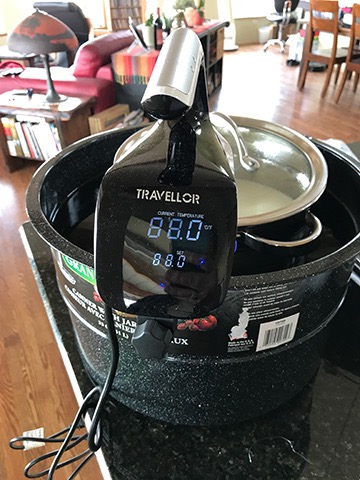A creative solution for an annoying problem.
If you’ve ever made cheese — I’m talking about real cheese like brie or butter cheese or cheddar — you know that one of the challenges facing a cheesemaker is raising the milk to an exact temperature and holding it there — sometimes for hours at a time. Unless you have a temperature-controlled cheesemaking vat — which I still haven’t found for home cheesemaking — you’re likely sitting by the stove making minute adjustments to the heat under the pot of water that your pot of cheese is sitting in — just to get the temperature of that to the magic temperature. It’s a nightmare that really makes cheesemaking an unpleasant chore.
A while back, I discovered immersion circulators, which I blogged about here. The circulator heats water to a temperature you specify and is commonly used for sous vide cooking. Trouble is, I didn’t pay close attention to what I was buying and it was only after I got it home that I realized the lowest temperature was higher than I needed to make most cheeses. It wouldn’t solve my problem. (But I did put it to use making sous vide steaks. I like grilled better. I’m pretty good with a grill.)
I experimented with a brewmaker’s mat that I wrapped around the outside of the pot. That was a so-so solution. It worked, but awkwardly. And it only worked on the pot I used for 2 gallon batches of milk; it wouldn’t work for the pot I’d need to buy for 4 gallon batches.
The other day, while surfing Amazon for something else, I decided to look at immersion circulators again. That’s when I found one that went as low as 77°F — the lowest temperature any of my cheese recipes required — the Sous Vide Travellortech Precision Cooker Immersion Circulator. I bought it.
That was only half the problem. I needed a pot big enough to put the cheesemaking pot and the sous vide cooker in. I found one at Fred Meyer: a huge, 33 quart canning pot.

Here’s my cheese pot solution. I don’t even need a stove to use it.
So yesterday I started a batch of brie using 2 gallons of milk. I put the milk in a stainless steel pot and lowered it into the canning pot. I fastened the immersion circulator onto the side of the canning pot. I filled the big pot with warm water to a point slightly higher than the level of the milk in the inner pot. I put a thermometer in the milk pot, programmed the immersion circulator for 88°F, set the timer for 2 hours, and turned it on.

The immersion circulator quickly got the water up to temperature.
Because I’d started with warm water, the temperature quickly got up to 88°F. And held there.
The temperature of the milk read high until I stirred it. It eventually leveled out at 88°F.
I added the molds, calcium chloride, and rennet, stirring after each one. Then I put a cover on the pot and left it to sit for 90 minutes, per the recipe.

I can monitor the milk temperature through the glass pot lid using a thermometer clipped to the side of the pot.
Every time I checked it, it was exactly 88°F.
No stove babysitting. No wandering temperatures. This is the first time I’ll be able to follow a recipe exactly because I’ll be able to keep the milk the exact temperature I need.
Cheesemaking might actually get fun.
I measured the opening and I’m pretty darn sure I’ll get the pot for 4 gallons of milk into my cheesemaking contraption. Butter cheese in next on my list.
Total cost of this solution: Immersion Circulator: $79. Huge canning pot: $32. I already had the other pots.
Discover more from An Eclectic Mind
Subscribe to get the latest posts sent to your email.
